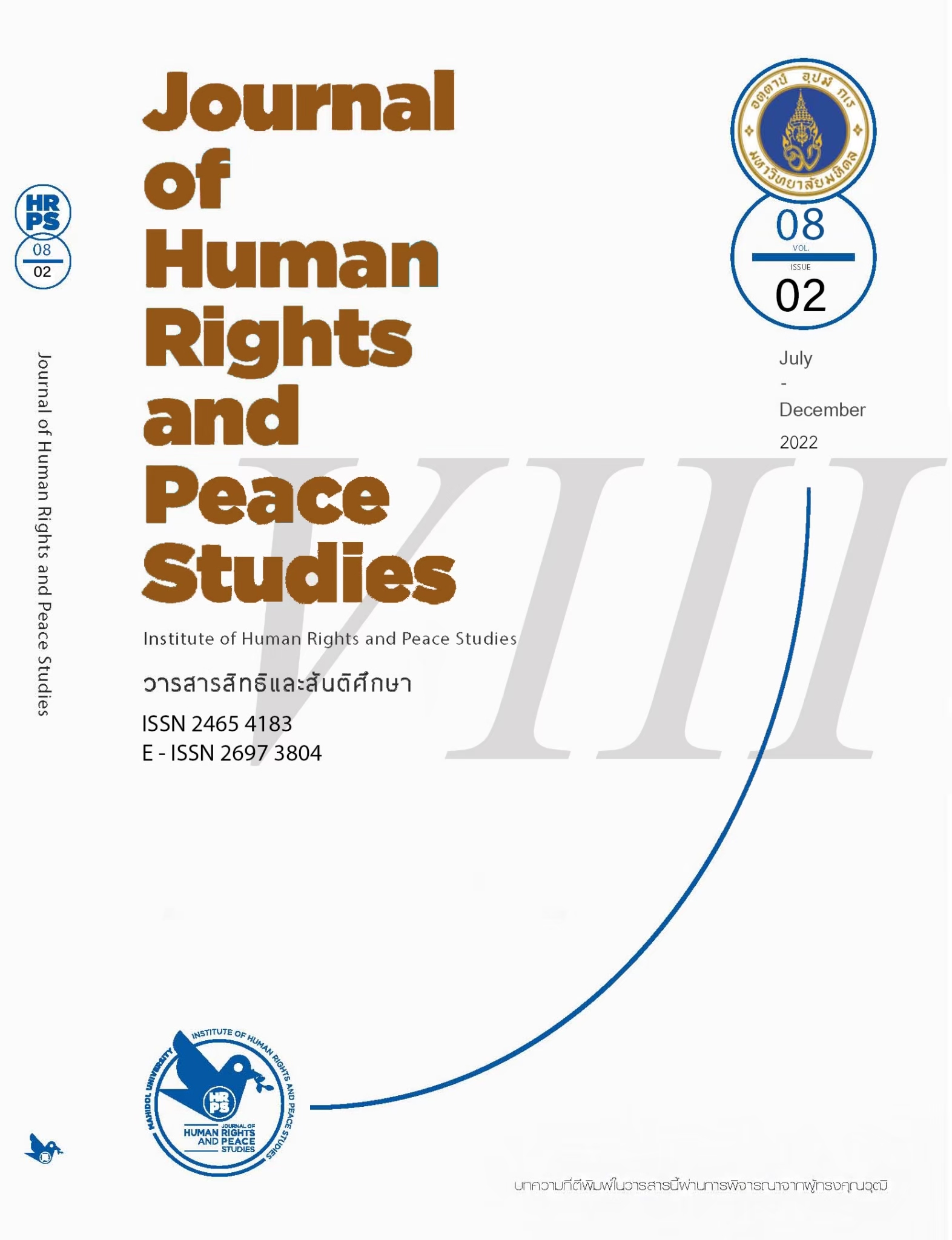Student activism in Indian universities: A means of improving human rights awareness
Main Article Content
Abstract
This study investigates the agency of university student activists in educating themselves and others about human rights, through engagement in grassroots campaigns for social justice within and beyond the campus. The study raises the following research questions: what are the sources of human rights consciousness that help building an understanding of human rights among student activists; what role does activism play in developing human rights consciousness of the student activists; and how student activists raise human rights consciousness among other students? To answer these questions, a critical qualitative methodology was employed. The study found out that historical, cultural, racial and family background plays a significant role in shaping the human rights and social justice worldview of the student activists. The youth activism offers varied opportunities to the student activists to strengthen their ideas of social justice and human rights consciousness. The building and strengthening of human rights consciousness leads to educating others about social justice and respect for human rights.
Article Details

This work is licensed under a Creative Commons Attribution-NonCommercial-NoDerivatives 4.0 International License.
The views, opinions, and pictures expressed in this journal are those of the authors and do not necessarily reflect the opinions and viewpoints of the editor and the editorial board. All rights are reserved by the authors and the Institute of Human Rights and Peace Studies of Mahidol University. No part of this journal may be reproduced, stored in a retrieval system, or transmitted in any form or by any means without the prior permission in writing from the journal’s editor, or as expressly permitted by law, or under terms agreed with the appropriate reprographics rights organization. Non-commercial use of information in this journal must be properly referenced.
References
Altbach, P. G. (1989). Perspectives on student political activism. Comparative Education, 25(1), 97-110. https://www.jstor.org/stable/3099006
Altbach, P. G. (1991). Student political activism. In P. G. Altbach (Ed.), International higher education: An encyclopedia. Garland.
Bay, C. (1967). Political and apolitical students: Facts in search of theory. Journal of Social Issues, 23(3), 76-91. https://doi.org/10.1111/j.1540-4560.1967.tb00587.x
Bergan, S. (2015). Conclusion: Democratic culture, education and student engagement. In M. Klemencic, S. Bergan, & R. Primozic (Eds.), Student engagement in Europe: Society, higher education and student governance. Council of Europe.
Braungart, R. G. (1971). Family status, socialization, and student politics: A multivariate analysis. American Journal of Sociology, 77(1), 108-130. https://doi.org/10.1086/225070
Carspecken, P. F. (1996). Critical ethnography in educational research. Routledge.
Carspecken, P. F. & Apple, M. W. (1992). Critical qualitative research, theory, method, and practice. In M. LeComte, W. Millroy, & J. Preissley (Eds.), Handbook of qualitative research in education (pp. 507-554). Academic.
Chandra, B., Mukherjee, M., Mukherjee, Panikkar, & Mahajan (1989). India’s struggle for independence. Penguin Books.
Davies, I., Evans, M., & Peterson, A. (Eds.) (2014). Civic activism, engagement and education: Issues and trends. Journal of Social Science Education, 13(4), 2-10. https://www.jsse.org/index.php/jsse/article/view/716/772
DeJaeghere, J., Josić, J. & McCleary, K. (2016). Education and youth agency: Qualitative case studies in global contexts. Springer.
Derbyshire, H. & Hodson, L. (2008). Performing injustice: Human rights and verbatim theatre. Law and Humanities, 2(2), 191-211. https://doi.org/10.1080/17521483.2008.11423751
Freire, P. (1998). Pedagogy of the oppressed (M. B. Ramos, Trans.) Continuum.
Habermas, J. (1987). Toward a rational society: Student protest, science, and politics (J. J. Shapiro, Trans.). Polity Press. (Original work published 1969).
Hall, G. (2019). Human rights activism: Factors which influence and motivate young adults in Australia. Human Rights Education Review, 2(2), 26-44. https://doi.org/10.7577/hrer.3295
Hazary, S. C. (1988). Protest politics of student youth in India. The Indian Journal of Political Science, 49(1), 105-120. https://www.jstor.org/stable/41855356
Kirshner, B. (2007). Youth activism as a context for learning and development. American Behavioral Scientist, 51(3), 367-379. https://doi.org/10.1177/0002764207306065
MacGregor, K. (2016, May 13). Student activism is advancing the anti-caste struggle. The University World News. https://www.universityworldnews.com/post.php?story=20160513170413125
Majumder, A. (2020, January 1). Apolitical: To be or not to be. Indian Academy of Sciences. http://confluence.ias.ac.in/apolitical-to-be-or-not-to-be/
McDevitt, M., & Chaffee, S. (2002). From top-down to trickle-up influence: Revisiting assumptions about the family in political socialization. Political Communication, 19(3), 281-301. https://doi.org/10.1080/01957470290055501
Ministry of Education. (2022). Report on Unified District Information System for Education Plus (UDISE+): 2021-22 flash statistics. Government of India. https://www.education.gov.in/sites/upload_files/mhrd/files/statistics-new/udise_21_22.pdf
Ministry of Human Resource Development. (2020). National education policy 2020. Government of India. https://www.education.gov.in/sites/upload_files/mhrd/files/NEP_Final_English_0.pdf
National Knowledge Commission. (2007). National knowledge commission: Report to the nation 2007. Government of India. https://epsiindia.org/wp-content/uploads/2019/02/Knowledge-Commission-Report-20071.pdf
Ortiz, I., & Cummins, M. (2011, April 9). Global inequality: Beyond the bottom billion-A rapid review of income distribution in 141 countries. UNICEF. https://papers.ssrn.com/sol3/papers.cfm?abstract_id=1805046
Ramaswamy, R. (2020, January 16). Disturbing your peace. Indian Academy of Sciences. http://confluence.ias.ac.in/disturbing-your-peace/
Raza, G. (2019, December 26). Educational potential of students’ movements. Indian Academy of Sciences. http://confluence.ias.ac.in/educational-potential-of-students-movements/
Reardon, B. A. (1995). Educating for human dignity: Learning about rights and responsibilities. University of Pennsylvania Press.
Sastry, S. (2020, January 17). Science, Galileo and student protests. Indian Academy of Sciences. http://confluence.ias.ac.in/science-galileo-and-student-protests/
Spivak, G. C. (2004). Righting wrongs. South Atlantic Quarterly, 103(2-3), 523-581. https://doi.org/10.1215/00382876-103-2-3-523
Tsutsui, K. & Wotipka, C. M. (2004). Global civil society and the international human rights movement: Citizen participation in human rights international nongovernmental organisations. Social Force, 83(2), 587-620. https://doi.org/10.1353/sof.2005.0022
Webster, D. W., & Sedlacek, W. E. (1987). The differential impact of a university student union on campus subgroups. NASPA Journal, 19(4), 48-52. https://doi.org/10.1080/00220973.1982.11071827
Westheimer, J., & Kahne, J. (2004). Educating the “Good” citizen: Political choices and pedagogical goals. PS Political Science and Politics, 37(2), 241-247. https://doi.org/10.1017/S1049096504004160


